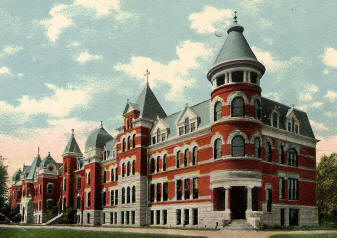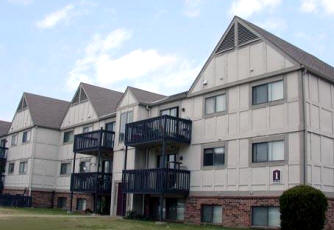|
Then and Now: Mt. Carmel Academy
|
|
THEN: Mt. Carmel Academy was enlarged twice, but each addition mimicked the style of the original building of brick and stone, resulting in one large cohesive structure. Image is from an original postcard. |
|
|
NOW: The original buildings of Mt. Carmel Academy have been replaced by the apartment complex of Mt. Carmel Village |
Old Mount Carmel is now apartment site
For decades, those driving on west Douglas could catch a glimpse of a stately building on elaborately laid-out grounds. It sat there so long people ceased to notice its presence, and then, when they looked again, it was gone.
The corner stone for what became Mt. Carmel Academy was laid Nov. 1, 1886, and the school opened the following September as All Hallows Academy, a Catholic girls boarding school run by the Sisters of Charity of the Blessed Virgin Mary, at Dubuque, Iowa.
The school began with four nuns as instructors and 21 students, who lived and attended classes in a four-story brick and stone building.
By July 1900 enrollment had grown to 88, with increases expected, so the board of directors decided to build an addition.
That first addition was to "conform to the main portion of the building, which is four stories high. To cost at least $15,000," according to the Wichita Eagle.
If "misery loves company," Wichitans complaining in 2007 about changed plans and rising costs of the arena might note that by September 1900 the cost estimate had grown from $15,000 to $30,000. And the actual cost was $40,000. Also, both the Eagle and the Beacon reported at different times that the structure was four stories and three stories and four stories again.
Original plans were to build the first addition to the south of the first and of similar design but serving as the main entrance. The second addition, which was built in 1906 was to be south of that, so that the original structure was on the north.
However the October 1904 Eagle stated the second addition was to be built north of the main building. And the January 1905 Eagle said that second addition was to be "three stories and the same size as the present building, thus doubling the capacity."
Whatever the final configuration and cost, the three buildings constructed over a 20 year span by three different contractors looked like one building.
During that time, several changes took place.
Bishop Hennessey gave a 700 pound bell to the school in 1891.
And he changed the name from All Hallows Academy to Mt. Carmel Academy in 1901. Originally a priest who graduated from "All Hallows" boys school in Ireland had christened the Wichita school in honor of his alma mater. However the Wichita Bishop did not think the name of a boys school was appropriate for "Wichita’s young ladies’ boarding school."
Forty acres were secured in 1902 to create a park surrounding Mt. Carmel Academy. Gates were added on the northeast and southeast corners and a curving boulevard led from the street to the front of the main building.
A 17 foot tall fountain was placed on the front lawn of the academy in 1911.
Mt. Carmel continued to operate into the 1950s, but a shortage in the number of sisters in schools operated by the order threatened to close the school in 1953. However the Eagle reported in March 1954 that the school would not close that spring but would re-open in the fall for high school girls only.
When a new Mount Carmel Academy was built in 1961 adjacent to Vickridge on East Central, the ornate building on west Douglas was occupied by the Notre Dame High School for boys. But they moved into new quarters in September 1964 when Bishop Carroll high school opened just a few blocks away.
The building was razed in 1965.
For a while the separate dormatory remained, but it, too, is now gone.
The only element left that might be original is the arched entry of stone and wrought iron at the southeast corner of the grounds which once opened to the curving drive added in 1902.
That entrance is no longer used as residents enter Mt. Carmel Village from the south.
(Notes for the above article were gathered, in part, from the Tihen Notes, Special Collections, WSU.)

